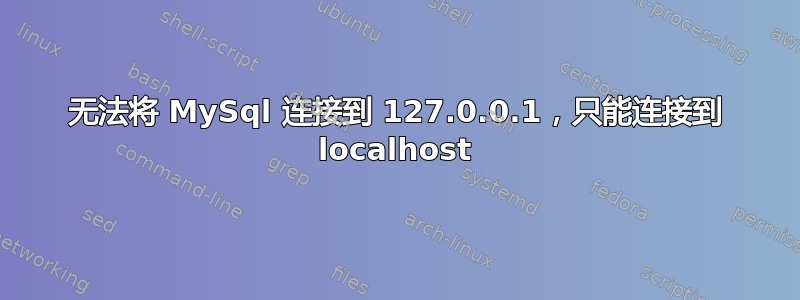
我有一个可移植版本的 MySQL 数据库,正尝试连接它。
在运行 Windows 10 的计算机上,我可以使用端口 3310 上的 127.0.0.1 连接到它。
如果我将该实例复制到任何其他运行 Windows 10 的计算机,我就可以使用 IP 进行连接。
当我将同一个实例复制到 Windows Server 2016 VPS 时,我无法使用 IP 地址连接到数据库,只有在使用 localhost 时才可以连接。
我需要使用 IP 地址进行连接。有人告诉我我的hosts文件可能出了问题,但两台电脑上的情况完全一样。
有人知道这可能是什么原因造成的吗?
--- 更新 1 ---
我知道那里,localhost而且127.0.0.1几乎一样。但对我来说问题是我使用的旧版软件只接受 IP 地址,所以我不能使用 localhost。
我无法将软件连接到数据库,然后我安装了 HeidiSQL 并尝试使用进行连接127.0.0.1,但它确实不起作用,所以我改为localhost并且它连接了。
由于我无法将旧软件更改为使用 localhost,因此我需要弄清楚为什么 MySQL 不接受通过127.0.0.1
-- 更新 2 --
这是 SQL 配置文件:
# Example MariaDB config file for large systems.
#
# This is for a large system with memory = 512M where the system runs mainly
# MariaDB.
#
# MariaDB programs look for option files in a set of
# locations which depend on the deployment platform.
# You can copy this option file to one of those
# locations. For information about these locations, do:
# 'my_print_defaults --help' and see what is printed under
# Default options are read from the following files in the given order:
# More information at: http://dev.mysql.com/doc/mysql/en/option-files.html
#
# In this file, you can use all long options that a program supports.
# If you want to know which options a program supports, run the program
# with the "--help" option.
# The following options will be passed to all MariaDB clients
[client]
#password = your_password
port = 3310
socket = /tmp/mysql.sock
# Here follows entries for some specific programs
# The MariaDB server
[mysqld]
port = 3310
socket = /tmp/mysql.sock
skip-external-locking
key_buffer_size = 256M
max_allowed_packet = 256M
table_open_cache = 256
sort_buffer_size = 1M
read_buffer_size = 1M
read_rnd_buffer_size = 4M
myisam_sort_buffer_size = 64M
thread_cache_size = 8
query_cache_size= 16M
# Try number of CPU's*2 for thread_concurrency
thread_concurrency = 8
# Point the following paths to different dedicated disks
#tmpdir = /tmp/
# Don't listen on a TCP/IP port at all. This can be a security enhancement,
# if all processes that need to connect to mysqld run on the same host.
# All interaction with mysqld must be made via Unix sockets or named pipes.
# Note that using this option without enabling named pipes on Windows
# (via the "enable-named-pipe" option) will render mysqld useless!
#
#skip-networking
# Replication Master Server (default)
# binary logging is required for replication
#log-bin=mysql-bin
# binary logging format - mixed recommended
#binlog_format=mixed
# required unique id between 1 and 2^32 - 1
# defaults to 1 if master-host is not set
# but will not function as a master if omitted
server-id = 1
# Replication Slave (comment out master section to use this)
#
# To configure this host as a replication slave, you can choose between
# two methods :
#
# 1) Use the CHANGE MASTER TO command (fully described in our manual) -
# the syntax is:
#
# CHANGE MASTER TO MASTER_HOST=<host>, MASTER_PORT=<port>,
# MASTER_USER=<user>, MASTER_PASSWORD=<password> ;
#
# where you replace <host>, <user>, <password> by quoted strings and
# <port> by the master's port number (3306 by default).
#
# Example:
#
# CHANGE MASTER TO MASTER_HOST='125.564.12.1', MASTER_PORT=3306,
# MASTER_USER='joe', MASTER_PASSWORD='secret';
#
# OR
#
# 2) Set the variables below. However, in case you choose this method, then
# start replication for the first time (even unsuccessfully, for example
# if you mistyped the password in master-password and the slave fails to
# connect), the slave will create a master.info file, and any later
# change in this file to the variables' values below will be ignored and
# overridden by the content of the master.info file, unless you shutdown
# the slave server, delete master.info and restart the slaver server.
# For that reason, you may want to leave the lines below untouched
# (commented) and instead use CHANGE MASTER TO (see above)
#
# required unique id between 2 and 2^32 - 1
# (and different from the master)
# defaults to 2 if master-host is set
# but will not function as a slave if omitted
#server-id = 2
#
# The replication master for this slave - required
#master-host = <hostname>
#
# The username the slave will use for authentication when connecting
# to the master - required
#master-user = <username>
#
# The password the slave will authenticate with when connecting to
# the master - required
#master-password = <password>
#
# The port the master is listening on.
# optional - defaults to 3306
#master-port = <port>
#
# binary logging - not required for slaves, but recommended
#log-bin=mysql-bin
# Uncomment the following if you are using InnoDB tables
#innodb_data_home_dir = C:\\mysql\\data\\
#innodb_data_file_path = ibdata1:10M:autoextend
#innodb_log_group_home_dir = C:\\mysql\\data\\
# You can set .._buffer_pool_size up to 50 - 80 %
# of RAM but beware of setting memory usage too high
#innodb_buffer_pool_size = 256M
#innodb_additional_mem_pool_size = 20M
# Set .._log_file_size to 25 % of buffer pool size
#innodb_log_file_size = 64M
#innodb_log_buffer_size = 8M
#innodb_flush_log_at_trx_commit = 1
#innodb_lock_wait_timeout = 50
[mysqldump]
quick
max_allowed_packet = 256M
[mysql]
no-auto-rehash
# Remove the next comment character if you are not familiar with SQL
#safe-updates
[myisamchk]
key_buffer_size = 128M
sort_buffer_size = 128M
read_buffer = 2M
write_buffer = 2M
[mysqlhotcopy]
interactive-timeout
答案1
默认情况下,mysql/mariadb 服务器配置仅监听 localhost (127.0.0.1)。要允许远程连接,您必须绑定到真实 IP 地址。您可以指定特定 IP 来限制。或者,您可以通过注释掉此行来绑定到所有 IP:
#bind-address = <some ip-address>
您发布了您的配置,但我没有看到此行,但请确保您的配置中的任何地方都没有绑定地址行。
还要确保您没有跳过网络配置。您需要注释掉此行:
#skip-networking
有关允许远程访问的更详细解释的文档位于此处: https://mariadb.com/kb/en/library/configuring-mariadb-for-remote-client-access/
您还需要创建一个允许从所有主机或您将要连接的特定主机或网络进行连接的用户。有关创建可以从远程主机连接的用户的详细信息,请参阅上面的 mariadb 文档链接。例如,要创建一个“bloguser”用户,该用户拥有“myblog”数据库中所有表的所有权限,并且可以从任何远程主机进行连接:
GRANT ALL PRIVILEGES ON myblog.* TO 'bloguser'@'%' IDENTIFIED BY 'bloguser-password';
当然,您的网络配置需要允许端口 3306(或您的自定义端口,如果已更改)通过您可能拥有的任何防火墙访问您的数据库。您可以使用 telnet 从远程主机测试基本网络访问。假设您的数据库服务器 IP 是 1.2.3.4。在远程计算机的命令行上,尝试:
telnet 1.2.3.4 3306
等待操作成功、失败或超时。以下是您可能会看到的一些结果及其可能的含义:
- “已连接到 1.2.3.4“ 成功!
- “无法连接到远程主机:连接超时“您有一条路由,但无法通过。可能是服务器上的防火墙不允许 3306。可能是您自己的网络不允许 3306 出站。
- “无法连接到远程主机:没有到主机的路由“您的系统甚至不知道如何接入该网络。
- “无法连接到远程主机:连接被拒绝“常见原因是 mariadb 没有运行或者没有监听该 IP 和端口(例如绑定到 127.0.0.1)。也可能是防火墙拒绝了连接。


